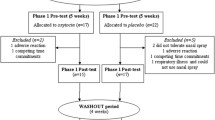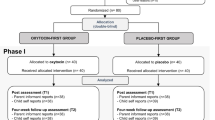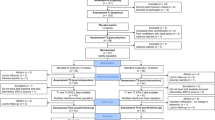Abstract
The last two decades have witnessed a surge in research investigating the application of oxytocin as a method of enhancing social behaviour in humans. Preliminary evidence suggests oxytocin may have potential as an intervention for autism. We evaluated a 5-day ‘live-in’ intervention using a double-blind randomized control trial. 38 male youths (7–16 years old) with autism spectrum disorders were administered 24 or 12 international units (depending on weight) intranasal placebo or oxytocin once daily over four consecutive days. The oxytocin or placebo was administered during parent–child interaction training sessions. Parent and child behaviours were assessed using parent reports, clinician ratings, and independent observations, at multiple time points to measure side-effects; social interaction skills; repetitive behaviours; emotion recognition and diagnostic status. Compared to placebo, intranasal oxytocin did not significantly improve emotion recognition, social interaction skills, or general behavioral adjustment in male youths with autism spectrum disorders. The results show that the benefits of nasal oxytocin for young individuals with autism spectrum disorders may be more circumscribed than suggested by previous studies, and suggest caution in recommending it as an intervention that is broadly effective.


Similar content being viewed by others
References
Adolphs, R., Sears, L., & Piven, J. (2001). Abnormal processing of social information from faces in autism. Journal of Cognitive Neuroscience, 13(2), 232–240.
American Psychiatric Association. (2000). Diagnostic and statistical manual of mental disorders (4th ed., text revision): DSM-IV-TR. Washington, DC: American Psychiatric Association.
Anagnostou, E., Soorya, L., Chaplin, W., Bartz, J., Halpern, D., Wasserman, S., et al. (2012). Intranasal oxytocin versus placebo in the treatment of adults with autism spectrum disorders: a randomised controlled trial. Molecular Autism,. doi:10.1186/2040-2392-3-16.
Andari, E., Duhamel, J.-R., Zalla, T., Herbrecht, E., Leboyer, M., & Sirigu, A. (2010). Promoting social behaviour with oxytocin in high-functioning autism spectrum disorders. Proceedings of the National Academy of Science, 107, 4389–4394.
Baron-Cohen, S. (2007). Mind reading the interactive guide to emotions. London: Jessica Kingsley Publishers.
Bartz, J. A., Zaki, J., Bolger, N., & Ochsner, K. N. (2011). Social effects of oxytocin in humans: Context and person matter. Trends in Cognitive Sciences, 15, 301–309.
Bellini, S., & Akullian, J. (2007). A meta-analysis of video modelling and video self-modeling interventions for children and adolescents with autism spectrum disorders. Council for Exceptional Children, 73, 264–287.
Bodfish, J. W., Symons, F. J., Parker, D. E., & Lewis, M. H. (2000). Varieties of repetitive behavior in autism: Comparisons to mental retardation. Journal of Autism and Development Disorders, 30, 237–243.
Bowlby, J., Ainsworth, M., & Bretherton, I. (1992). The origins of attachment theory. Developmental Psychology, 28, 759–775.
Campbell, D. B., Datta, D., Jones, S. T., Lee, E. B., Sutcliffe, J. S., Hammock, E. A. D., et al. (2011). Association of oxytocin receptor (OXTR) gene variants with multiply phenotype domains of autism spectrum disorder. Journal of Neurodevelopmental Disorders, 3, 101–112.
Constantino, J. N., & Gruber, C. P. (2005). Social Responsiveness Scale (SRS) manual. Los Angeles, CA: Western Psychological Services.
Dadds, M. R., Allen, J. L., Oliver, B. R., Faulkner, N., Legge, K., Moul, C., et al. (2012). Love, eye contact and the developmental origins of empathy v. psychopathy. British Journal of Psychiatry, 200, 191–196.
Dadds, M. R., El Masry, Y., Wimalaweera, S., & Guastella, A. J. (2008). Reduced eye gaze explains ‘fear blindness’ in childhood psychopathic traits. Journal of the American Academy of Child and Adolescent Psychiatry, 47, 455–463.
Dadds, M. R., Hawes, D., & Merz, S. (2004). The UNSW facial emotion task. Sydney: Department of Psychology, University of New South Wales.
Dawson, G. (2008). Early behavioural intervention, brain plasticity, and the prevention of autism spectrum disorders. Development and Psychopathology, 20, 775–803.
Dawson, G., Berniers, R., & Ring, R. H. (2012). Social attention: a possible early indicator of efficacy in autism clinical trials. Journal of Neurological Disorders, 4(11), 1–12.
De Vries, G. J. (2008). Sex differences in vasopressin and oxytocin innervation of the brain. Progress in Brain Research, 170, 17–27.
Ehlers, S., Gillberg, C., & Wing, L. (1999). A screening questionnaire for Asperger syndrome and other high-functioning autism spectrum disorders in school age children. Journal of Autism and Developmental Disorders, 29, 129–141.
Gamer, M., Zurowski, B., & Buchel, C. (2010). Different amygdala subregions mediate valence-related and attentional effects of oxytocin in humans. Proceedings of the National Academy of Sciences of the USA, 107, 9400–9405.
Green, L. A., Fein, D., Modahl, C., Feinstein, C., Waterhouse, L., & Morris, M. (2001). Oxytocin and autistic disorder: Alterations in peptide forms. Biological Psychiatry, 50(8), 609–613.
Gregory, S., Connelly, J., Towers, A., Johnson, J., Biscocho, D., Markunas, C., et al. (2009). Genomic and epigenetic evidence for oxytocin receptor deficiency in autism. BMC Medicine, 7(1), 62.
Gresham, F. M., & Elliot, S. N. (1990). Social skills rating scale. Circle Pines, MN: American Guidance Service.
Guastella, A. J., Einfeld, S. L., Gray, K. M., Rinehart, N. J., Tonge, B. J., Lambert, T. J., et al. (2010). Intranasal oxytocin improves emotion recognition for youth with autism spectrum disorders. Biological Psychiatry, 67, 692–694.
Guastella, A. J., & Macleod, C. (2012). A critical review of the influence of oxytocin nasal spray on social cognition in humans: Evidence and future directions. Hormones and Behavior, 61, 410–418.
Guastella, A. J., Mitchell, P. B., & Dadds, M. R. (2008). Oxytocin increases gaze to the eye region of human faces. Biological Psychiatry, 63, 3–5.
Hollander, E., Bartz, J., Chaplin, W., Phillips, A., Sumner, J., Soorya, L., et al. (2007). Oxytocin increases retention of social cognition in autism. Biological Psychiatry, 61, 498–503.
Hollander, E., Novotny, S., Hanratty, M., Yaffe, R., DeCaria, C. M., Aronowitx, B. R., et al. (2003). Oxytocin infusion reduces repetitive behaviours in adults with autistic and Asperger’s disorders. Neuropsychopharmacology, 28, 193–198.
Ijzendoorn, M. H. V., & Bakermans-Kranenburg, M. J. (2012). A sniff of trust: Meta-analysis of the effects of intranasal oxytocin administration on face recognition, trust to in-group, and trust to out-group. Psychoneuroendocrinology, 37(3), 438–443.
Insel, T. R. (2010). The challenge of translation in social neuroscience: A review of oxytocin, vasopressin, and affiliation behaviour. Neuron, 65, 768–779.
Johnson, M. H., Griffin, R., Csibra, G., Halit, H., Farroni, T., de Haan, M., et al. (2005). The emergence of the social brain network: Evidence from typical and atypical development. Development and Psychopathology, 17, 599–619.
Kennedy, H. (2011). What is video interaction guidance (VIG)? In H. Kennedy, M. Lawlor, & L. Todd (Eds.), Video interaction guidance: A relationship-based intervention to promote attunement, empathy and wellbeing. London: Jessica Kingsley Publishers.
Kosfeld, M., Heinrichs, M., Zaks, P. J., Fischbacker, U., & Fehr, E. (2005). Oxytocin increases trust in humans. Nature, 435, 673–676.
Kroeger, K., Schultz, J., & Newsom, C. (2007). A comparison of two group-delivered social skills programs for young children with autism. Journal of Autism and Developmental Disorders, 37, 808–817.
Lerer, E., Levi, S., Salomon, S., Darvasi, A., Yirmiya, N., & Ebstein, R. P. (2008). Association between the oxytocin receptor (OXTR) gene and autism: Relationship to Vineland Adaptive Behavior Scales and cognition. Molecular Psychiatry, 13, 980–988.
Lim, M. M., & Young, L. J. (2006). Neuropeptidergic regulation of affiliative behavior and social bonding in animals. Hormones and Behavior, 50, 506–517.
Lord, C., Petkova, E., Hus, V., Gan, W., Lu, F., Martin, D. M., et al. (2012). A multisite study of the clinical diagnosis of different autism spectrum disorders. Archives of General Psychiatry, 69, 306–313.
MacDonald, E., & Dadds, M. R. (2010). Family observation schedule—Autism spectrum disorders. Unpublished manuscript, University of New South Wales. Available from authors.
MacDonald, E., Dadds, M. R., Brennan, J. L., Williams, K., & Levy, F. (2011). A review of safety, side-effects and subjective reactions to intranasal oxytocin in human research. Psychoneuroendocrinology, 36, 1114–1126.
MacDonald, K., & MacDonald, T. M. (2010). The peptide that binds: A systematic review of oxytocin and its prosocial effects in humans. Harvard Review of Psychiatry, 18(1), 1–21.
Marcus, D. J., & Nelson, C. A. (2001). Neural bases and development of face recognition in autism. CNS Spectrums, 6, 36–59.
Miller, M., Bales, K. L., Taylor, S. L., Yoon, J., Hostetler, C. M., Carter, C. S., et al. (2013). Oxytocin and vasopressin in children and adolescents with autism spectrum disorders: sex differences and associations with symptoms. Autism Research. February 14. doi:10.1002/aur.1270.
Modahl, C., Green, L. A., Fein, D., Morris, M., Waterhouse, L., Feinstein, C., et al. (1998). Plasma oxytocin levels in autistic children. Biological Psychiatry, 43(4), 270–277.
Novartis Pharmaceuticals. (2009). Novartis Australia health care professionals. Available at http://www.novartis.com.au/products_healthcare.html.
Pasalich, D., & Dadds, M. R. (2009). Family observation schedule VI. Unpublished manuscript, University of New South Wales. Available from authors.
Patterson, G. R. (1982). A social learning approach (vol 3): Coercive family process. Eugene, OR: Castalia Publishing Company.
Reichow, B., & Volkmar, F. (2010). Social skills interventions for individuals with autism: Evaluation for evidence-based practices within a best evidence synthesis framework. Journal of Autism and Developmental Disorders, 40, 149–166.
Schopler, E. C., Reichler, R. J., & Renner, B. R. (1988). The Childhood Autism Rating Scale (CARS). Los Angeles, CA: Western Psychological Services.
Simonoff, E., Pickles, A., Charman, T., Chandler, S., Loucas, T., & Baird, G. (2008). Psychiatric disorders in children with autism spectrum: Prevalence, comorbidity and associated factors in a population-derived sample. Journal of the American Academy of Child & Adolescent Psychiatry, 47, 921–929.
Simplicio, D. M., Massey-Chase, R., Cowen, P. J., & Harmer, C. J. (2009). Oxytocin enhances processing of positive versus negative emotional information in healthy male volunteers. Journal of Psychopharmacology, 23, 241.
Tachibana, M., Kagitani-Shimono, K., Mohri, I., Yamamoto, T., Sanefuji, W., Nakamura, A., et al. (2013). Long-term administration of intranasal oxytocin is a safe and promising therapy for early adolescent boys with autism spectrum disorders. Journal of Child and Adolescent Psychopharmacology, 23(2), 123–127. doi:10.1089/cap.2012.0048.
The OSU Research Unit on Paediatric Psychopharmacology. (2005a). OSU Autism Rating Scale-DSM-IV (OARS-4). Columbus, OH: The OSU Research Unit on Paediatric Psychopharmacology.
The OSU Research Unit on Paediatric Psychopharmacology. (2005b). OSU autism CGI. Columbus, OH: The OSU Research Unit on Paediatric Psychopharmacology.
Trevarthen, C., & Aitken, K. J. (2001). Infant intersubjectivity: Research, theory, and clinical application. Journal of Child Psychology and Psychiatry, 42, 3–48.
Wechsler, D. (2005). Wechsler Intelligence Scale for children (WISC-IV) (4th ed.). Sydney, Australia: Harcourt Assessment.
Young, L. J. (2002). The neurobiology of social recognition, approach, and avoidance. Biological Psychiatry, 51, 18–26.
Acknowledgments
Funding for this research was supported by project Grant #568694 from the National Health and Medical Research Council of Australia to the first author. The authors wish to thank Royal Far West and the participating families for their support.
Conflict of interest
The authors report no financial interests or potential conflicts of interest.
Author information
Authors and Affiliations
Corresponding author
Electronic supplementary material
Below is the link to the electronic supplementary material.
Rights and permissions
About this article
Cite this article
Dadds, M.R., MacDonald, E., Cauchi, A. et al. Nasal Oxytocin for Social Deficits in Childhood Autism: A Randomized Controlled Trial. J Autism Dev Disord 44, 521–531 (2014). https://doi.org/10.1007/s10803-013-1899-3
Published:
Issue Date:
DOI: https://doi.org/10.1007/s10803-013-1899-3




